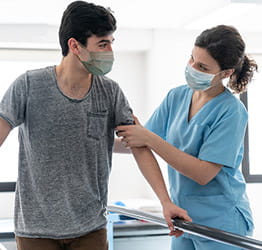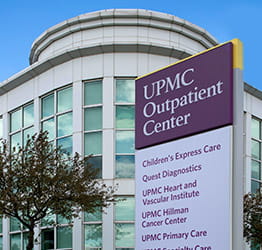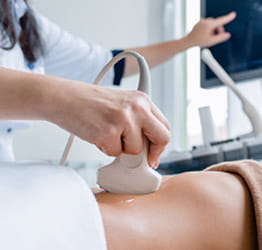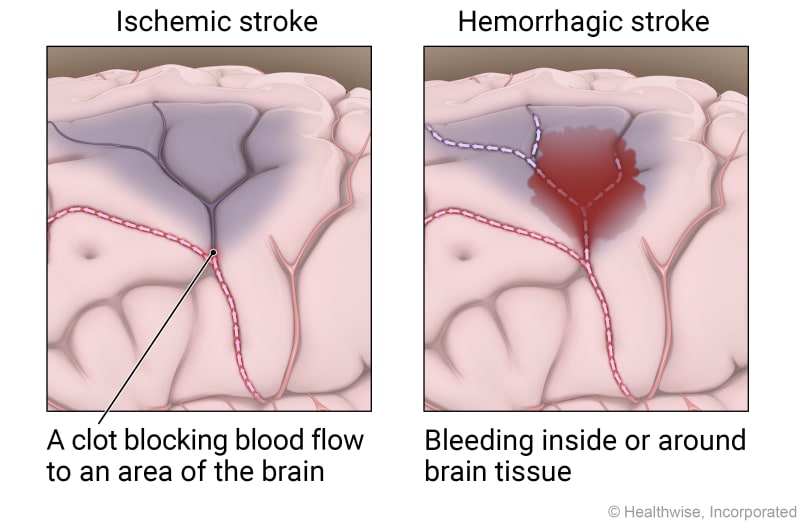On this page
What Is a Stroke?
Stroke is the leading cause of disability among adults in the U.S. and is among the leading causes of death. It happens when blocked or bleeding blood vessels in the brain decrease blood flow to brain tissue. This blockage or bleeding can cause brain cells to die.
What are the types of strokes?
Types of strokes include:
- Hemorrhagic stroke — Occurs when a blood vessel in your brain becomes weak and bursts, causing blood to leak into your brain.
- Ischemic stroke — Occurs when a blood vessel supplying blood to your brain is blocked by a blood clot. The clot can form in an already narrow artery (thrombotic stroke) or travel to a narrow artery in your brain from another blood vessel in your brain or body (cerebral embolism or embolic stroke). Ischemic strokes are the most common type of stroke, making up 87% of all strokes.
- Transient ischemic attack (TIA) — Also known as a mini-stroke, a TIA occurs when blood flow to your brain is temporarily blocked. TIA causes stroke symptoms that last for a short time and then go away without causing permanent damage. A TIA is often a warning sign that a more severe stroke may happen soon.
Stroke
A stroke is a sudden disruption in blood flow to the brain caused by a blockage of a blood vessel (ischemic stroke) or bleeding of a blood vessel (hemorrhagic stroke). Areas of the brain that are affected by the blockage or bleeding can become damaged within minutes. The effects of a stroke may be mild or severe and temporary or permanent. The effects depend on which brain cells are damaged, how much of the brain is involved, and how quickly the blood supply is restored to the area.
© 2016-2025 Healthwise, Incorporated. This information does not replace the advice of a doctor.
How common is stroke?
In the United States, stroke affects more than 750,000 people each year. It's the leading cause of adult disability and among the leading causes of death.
What causes stroke?
A stroke most often occurs when blood flow to the brain becomes blocked (called ischemic stroke).
Blockage can be caused by:
- A buildup of atherosclerotic plaque (fatty substances) along the inner lining of an artery causing it to narrow, reduce elasticity, and decrease blood flow.
- A clot that forms in an artery supplying blood to the brain.
- A clot that forms somewhere in the body — often the heart — and breaks free, traveling to an artery supplying blood to the brain and lodging there.
A stroke may also occur if a blood vessel breaks and bleeds into or around the brain. If a blood vessel bursts, it is called a hemorrhagic stroke.
What are stroke risk factors and complications?
There are two types of stroke risk factors: Modifiable risk factors can be changed, and nonmodifiable risk factors cannot be changed.
Modifiable stroke risk factors
Some stroke risk factors can be reduced by changing personal habits or receiving medical treatment.
Modifiable risk factors include:
Nonmodifiable stroke risk factors
Increased risks based on medical history, age, and race are called nonmodifiable risk factors because you cannot change them.
Nonmodifiable risk factors include:
- Being African American.
- Being over age 60.
- Cardiovascular disease.
- Family members who've had strokes.
- Having a prior stroke or transient ischemic attack (TIA).
Complications of stroke
A stroke is a medical emergency that happens when blood flow is cut off to a portion of the brain. Without blood flow, brain cells can die within minutes.
Stroke requires fast treatment to reduce your risk of disability and death. If left untreated, stroke can cause death or a permanent loss or impairment of function controlled by the affected part of your brain.
How can I prevent stroke?
You may not be able to control some of your stroke risk factors, such as your age. However, preventing heart disease and chronic conditions can reduce the risk that you will have a stroke.
You may be able to reduce your risk by:
- Eating a diet that is rich in fruits, vegetables, and whole grains.
- Exercising and maintaining a healthy weight.
- Maintaining normal blood pressure and cholesterol levels.
- Avoiding smoking.
- Limiting alcoholic beverages.
Back to top.
What Are the Signs and Symptoms of Stroke?
Stroke symptoms usually develop suddenly and without warning.
Depending on which parts of the brain are affected by the stroke, symptoms may:
- Be severe and fade.
- Occur off and on.
- Start mild and worsen.
Stroke symptoms may include:
- Difficulty walking or moving.
- Dizziness.
- Loss of consciousness or seizure.
- Nausea or vomiting.
- Numbness or weakness in your face or limbs that may affect only one side of your body.
- Problems with balance or coordination.
- Severe headache.
- Trouble speaking or understanding.
- Vision problems in one or both eyes.
Symptoms of TIA
Some people experience a “warning stroke,” or transient ischemic attack (TIA). These are symptoms of a stroke that go away completely, usually within hours. People who have had a TIA are at an increased risk of having an actual stroke soon.
When should I see a doctor about my stroke symptoms?
A stroke is life-threatening and needs emergency treatment. If you have symptoms of a stroke, dial 911 right away — don’t wait.
Getting fast treatment can reduce your risk of disability and death.
Back to top.
How Do You Diagnose Stroke?
To diagnose stroke, your doctor will perform a physical exam and order imaging tests.
What to expect during your visit
When you arrive at the hospital, your doctor will:
- Order imaging or other tests.
- Perform a physical exam.
- Review your health history and medications.
Tests to diagnose stroke
Your doctor may request imaging tests to examine how blood flows through the blood vessels in your brain and check for signs of stroke. Diagnostic tests for stroke include:
- CT or MR angiogram — Also known as arteriography or an arteriogram, this test uses x-rays or magnets and a special contrast dye to look for problems with the blood vessels in your brain.
- CT scan — A test that creates images of your brain and is used to diagnose stroke, brain aneurysm, or another type of brain injury.
- Doppler ultrasound — A noninvasive test that uses ultrasound waves to measure blood flow through your arteries and veins.
- MRI — Uses a combination of large magnets, radio frequencies, and a computer to produce detailed images of your brain.
Stroke prognosis
Stroke is a life-threatening condition. Your prognosis after a stroke will depend on the severity of the blockage or bleeding, what part of your brain is affected, and how quickly you receive medical care.
What can I expect during stroke recovery?
Your recovery after a stroke will depend on your symptoms and the amount of brain damage you experience. Some people have no deficits after a stroke and can resume their normal activities, but others experience severe side effects that cause a loss of independence.
Side effects after stroke may include:
- Cognitive problems with thinking, reasoning, or judgment.
- Difficulty swallowing, speaking, or understanding speech.
- Incontinence.
- Memory problems.
- Mood disorders, such as depression, anxiety, or mood swings.
- Pain, numbness, or tingling.
- Problems with balance or coordination.
- Trouble regulating emotions and emotional outbursts.
- Vision problems.
- Weakness, paralysis, or problems with movement.
You may need inpatient or outpatient physical, occupational, or speech therapy after your stroke to help improve or manage side effects. Some people may see improvement in their side effects over time as their brain begins to heal, but others may have permanent disability.
Back to top.
How Do You Treat Stroke?
The goals of stroke treatment are restoring blood flow by removing the blockage or stopping the bleeding while also preventing permanent brain damage that can lead to disability and death. Your stroke treatment depends on:
- The location, extent, and duration of the blockage or bleeding.
- Your overall condition.
Treatment may include:
Medication to treat stroke
Your doctor may administer emergency medications to treat stroke and related symptoms, including:
- Anti-inflammatory medications — These medications help to control brain swelling.
- Neuroprotective medications — These medications protect your brain from damage caused by a lack of oxygen.
- Thrombolytics or fibrinolytics — Known as clot-busting medications, these drugs dissolve blood clots that cause blocked arteries in your brain. A common medication is called tissue plasminogen activator (tPA). To be effective, these medications must be given within a few hours of the start of your stroke symptoms.
After you receive emergency care for stroke, your doctor may prescribe other medications for you to take on a short- or long-term basis, including:
- Antiplatelet medications, such as aspirin and clopidogrel.
- Blood pressure medications, such as diuretics and beta blockers.
- Blood-thinners (anticoagulants), such as warfarin.
- Statins to control cholesterol levels.
Endovascular procedures to treat ischemic stroke
Endovascular procedures provide minimally invasive treatment for ischemic stroke using thin, flexible tubes called catheters. Endovascular procedures include removing the blood clot and administering clot-dissolving medication directly to the site of the blood clot in your brain.
During an endovascular procedure, your doctor will:
- Insert a small, thin tube called a catheter through a small incision in your groin or wrist.
- Use x-ray imaging to guide the catheter to the blood clot site in your brain.
- Use a special tool to remove the blood clot or administer medication to dissolve the blood clot.
- Remove the catheter and close the incision.
Types of endovascular procedures include:
Intra-arterial thrombolytic treatment
Intra-arterial thrombolytic treatment utilizes a long tube threaded through a blood vessel and into the brain to deliver thrombolytic (clot-busting) drugs, such as tPA, directly to the site of a blood clot causing a stroke.
Mechanical thrombectomy using a stent retriever
Mechanical thrombectomy using a stent retriever is a groundbreaking stroke treatment pioneered by researchers at UPMC and other facilities worldwide. In the procedure, a catheter is threaded through the artery to the point of the clot. A stent is inserted into the catheter, which can trap and remove the clot.
Minimally invasive surgery for hemorrhagic stroke
UPMC surgeons perform minimally invasive procedures to treat hemorrhagic stroke by draining blood from the affected area of the brain and repairing the source of the bleeding.
These procedures can be performed through a small incision in the scalp or using a catheter that is inserted into a blood vessel and guided to the site of the brain bleed. Procedures include:
- Aneurysm clipping — Involves placing a metal clip around the base of an aneurysm to control bleeding.
- Embolization — Blocks blood flow to abnormal blood vessels.
- Endoscopic evacuation — Uses a small instrument with a camera to remove blood clots from your brain.
- Endovascular coiling — Uses small coils to block blood flow to an aneurysm.
- External ventricular drain (EVD) — Uses a thin, flexible tube called a catheter to drain fluid and blood from your brain.
- Flow diverters — Uses small devices to block blood flow to an aneurysm.
- Stereotactic aspiration — Uses imaging guidance and small surgical instruments to remove blood clots from your brain.
Stroke neurosurgery
Stroke neurosurgery concentrates on surgically bypassing and opening blocked vessels in your brain, as well as controlling bleeding in some types of hemorrhagic strokes.
If you are not a candidate for a minimally invasive endovascular procedure, your doctor may recommend a procedure called craniotomy to treat your ischemic stroke. It involves removing a piece of your skull to access your brain and remove the blood clot.
UPMC experts also offer neural implantation for stroke — a minimally invasive, investigational treatment therapy first performed at UPMC. During this treatment, engineered nerve cells are placed in stroke-damaged areas of the brain to replace nerve cells killed by a stroke.
Why choose UPMC for stroke care?
When you choose UPMC for stroke care, you will receive:
- Access to world-class neuroscience expertise — UPMC is among the world’s best multidisciplinary stroke centers. When surgery is necessary, our neurosurgery team is experienced in advanced treatments, including traditional and investigational approaches that are not widely available.
- A full range of treatment options — We offer nonsurgical and minimally invasive stroke care, as well as traditional open surgical procedures, allowing us to effectively treat all types of strokes while reducing your risk of complications.
- Multidisciplinary care — We partner with neurologists, rehabilitation specialists, and other medical experts to provide complete care that optimizes your recovery and quality of life.
Back to top.
By UPMC Editorial Staff. Last reviewed on 2025-10-23.

















